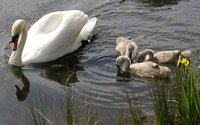Mute Swan
|
|
| Mute Swan Conservation status: Secure | ||||||||||||||
|---|---|---|---|---|---|---|---|---|---|---|---|---|---|---|
 | ||||||||||||||
| Scientific classification | ||||||||||||||
| ||||||||||||||
| Binomial name | ||||||||||||||
| Cygnus olor Gmelin, 1789 |
The Mute Swan (Cygnus olor) is a common Eurasian member of the duck, goose and swan family Anatidae.
This bird is found naturally mainly in temperate areas of Europe and western Asia. It is not migratory, although eastern populations must move in winter when the lakes freeze.
Owing to its looks, this species is often kept in captivity to decorate parks and ponds, and descendants of such birds have become naturalised in the eastern United States and Great Lakes. In some locations, such as Chesapeake Bay, the numbers of these feral birds has increased to the point where they are considered pests because they compete with native birds for habitat and food.
This huge swan is 125-155 cm long with a 200-240 cm wingspan. They stand over 1.2 m (four feet) tall. Males are larger than females. This is one of the heaviest flying birds, with males weighing more than 12kg (27 lb), and females more than 11 kg (25 lb).
Its size, orange-reddish bill and white plumage make this swan almost unmistakable. The most similar species is Whooper Swan, but that has a yellow and black bill, and lacks the curved "swan" neck and is longer and heavier.
Young birds, called "cygnets", are greyish rather than white, and lack the bright orange bill.
Swans.jpg
Mute Swans nest on large mounds that they build in the middle of a shallow lake. These monogamous birds reuse the same nest each year, restoring or rebuilding it as needed. Male and female swans share the care of the nest, and once the cygnets are fledged it is not uncommon to see whole families looking for food. They feed on submerged aquatic vegetation, reached with their long bills.
ISU_mute_swans.jpg
Although this bird can be tame, especially to those who feed it daily, it is aggressive in defence of its nest, and its size and impressive hissing make it a formidable adversary for animals as large as a fox; a grunt, on the other hand, may be a positive signal. There have been many reports of Mute Swans attacking people who enter their territory.
However, the Mute Swan is less vocal than the noisy Whooper and Bewick's Swans; the most familiar sound associated with Mute Swan is the whooshing of the wings in flight once this bird has laboriously taken off from the water. Unlike Black Swans, Mute Swans are strongly territorial. The familiar pose with neck curved back and wings half raised is a threat display.
The Mute Swan is protected in most of its range, but this has not prevented illegal hunting and poaching.
| Contents |
References
Trivia
- All Mute Swans in the UK are considered the property of the British monarch, except for flocks owned by the Vintners' and Dyers' Companies. See Swan Upping.
- The Mute Swans in the moat at The Bishops Palace at Wells Cathedral in Wells, England have for centuries been trained to ring bells via strings attached to them to beg for food. Two Swans are still able to ring for lunch.
- Bell Ringing Swans Of Wells, England Official Website (http://www.bishopspalacewells.co.uk/wildlife.php)
- A Mute Swan in City Island, the Bronx, New York, can speak like a Parrot.*[1] (http://groups.yahoo.com/group/AudreyHepburnSwan/)
See also
External links
- Cathedral Swan Pool (http://www.somerset.gov.uk/archives/Images/Postcard2/0JON4/0JON492.jpg) - image from the Postcard Collection at www.somerset.gov.uk
- Swan Ringing a Bell (http://www.somerset.gov.uk/archives/Images/Postcard2/0JON4/0JON466.jpg) - image from the Postcard Collection at www.somerset.gov.uk
- Swans Ring Bells (http://www.somerset.gov.uk/archives/Images/Postcard2/0JON4/0JON467.jpg) - image from the Postcard Collection at www.somerset.gov.uk
- The Mute Swan (http://www.tintota.com/archive/muteswan.htm) - written by Sylvia Roff-Marsh and hosted at tintota.combg:Ням лебед
da:Knopsvane de:Höckerschwan eo:Muta cigno fr:Cygne tuberculé fy:Knobbelswan lt:Gulbė nebylė nl:Knobbelzwaan ja:コブハクチョウ pl:Łabędź niemy fi:Kyhmyjoutsen sv:Knölsvan

